MOVE
Energize your workday with upper-body chair yoga
Chair yoga -- practicing yoga postures and stretches while seated -- can help you relieve tension, prevent stress and create a sense of well-being and balance. Here are some good upper body stretches you can fit in throughout your day to ease tension, get more energized or to calm down during a chaotic
time.
Three-part
wave breath
Take a deep breath with intention to help soothe stress:
- Sit comfortably with your eyes closed.
- Place one hand on your chest, one hand on your lower belly.
- Observe the natural rhythm of your breathing as you breathe in and out through your nose.
- Lengthen and expand your breath.
- Inhale and expand your belly, pushing against your lower hand. Breathe outward into your ribs. Continue the deep breath, expanding your chest, opening your collar bones and throat.
- Exhale slowly, allowing your chest and ribs to relax into place. Draw your belly in at the end of the exhale.
- Continue for one to five minutes or more until you feel calmer.
Yoga
postures and stretches
The following upper-body exercises can be done together or one at a time throughout your day. They help you focus on the areas where you feel tense. With each posture or stretch, sustain a deep and steady breath. Hold
each position for 30 to 60 seconds or more. Don't strain or cause pain; allow each posture to gently stretch and erase tension.
Neck
release:
- Tuck your chin (make a double chin).
- Roll your chin toward your chest. Create a stretch behind your head and hold.
- Keep your chin tucked. Look to the right and hold. Look to the left and hold.
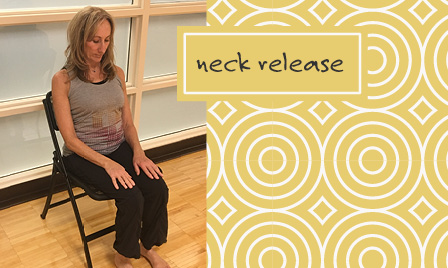
Hand, wrist and elbow rescue:
- Hands: Face palms toward each other, with your fingertips touching. Stretch your fingers apart. Press palms toward each other to stretch in between and the backs of the fingers.
- Wrist/elbow: Reach your right arm forward, palm turned upward with your elbow straight. Reach out with your left arm, join palms together and press right fingers toward floor. Repeat on the other side.
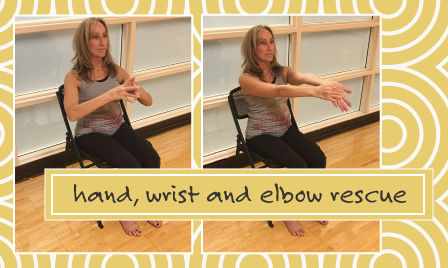
Torso,
back and shoulder flow:
- Interlace your fingers. Turn your palms away from your body. Inhale. Straighten your arms. Press palms forward and stretch your torso forward. Lift your torso upright and hands overhead. Exhale—arms float down to sides.
- Repeat above three to five times.
- Last time:
- Torso and
shoulder release: Hold your arms above your head, fingers interlaced, palms toward the sky. Press upward through your palms. Stretch across front of shoulders and chest, hold.
- Upper back
opener: Reach arms forward, pressing palms forward. Round upper back, tuck in chin. Move hands side to side. Stretch behind and between shoulder blades, hold.
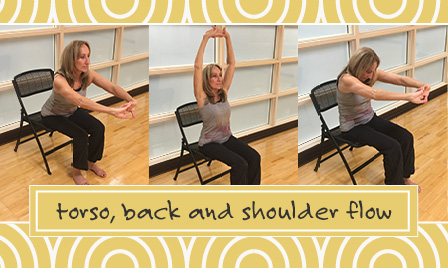
Energizing
backbend, chest opener:
- Place hands on hips or lower back. Inhale, lifting your chest up. Look up. Pull your elbows back. Open your shoulders, expand your chest, hold.
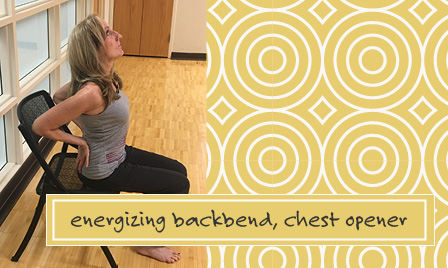
Spinal
stretch:
- Place your feet 12 to 18 inches apart. Inhale, arms up. Exhale, round your torso forward. Rest your forearms on your thighs. Let your spine round. Relax your head and neck, hold.
- Inhale, pull belly muscles in. Slowly roll up. Stretch arms overhead, exhale, and return hands to lap.
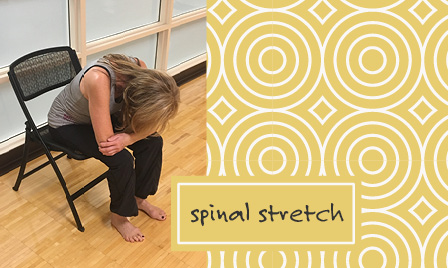
Half-moon
– side bend:
- Inhale, reach left arm up, right arm down. Lift and lengthen the spine. Exhale, bend torso toward the right; keep shoulders square, hold.
- Repeat on the left side.
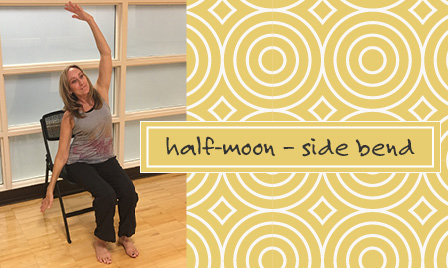
Soothing
seated twist:
- Inhale, arms up. Exhale turn torso to the right—place left hand to right knee—right hand to seat or back of chair. Inhale sit tall—exhale open the chest—broaden the shoulders—hold.
- Repeat on the left side.
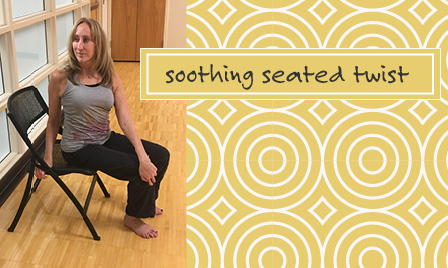
Progressive
muscle relaxation for upper body:
The process of tightening and relaxing your muscles helps you become aware of any muscle tension. Tension can aggravate stress, which can increase muscle tension even further. Use this technique to help break the stress-tension cycle and to relax any time. For
this technique:
- Sit back into your chair with a tall spine.
- Reach your arms forward. Make a fist. Tighten your arms, chest, upper back, shoulders, jaw and forehead. Pause and notice how your tense, contracted muscles feel.
- Inhale slowly and deeply. Exhale very slowly; gradually lower hands to your lap.
- Continue to breathe deeply.
- Release palms to your lap—spread your fingers. Allow arms to hang heavy from the shoulders into your palms.
- Release tension from the upper back, shoulders and chest.
- Allow your forehead to soften and your jaw to release. Relax your entire face.
- Repeat three to five times or until you feel free of tension.
- Continue to breathe deeply—scan your body for remaining signs of tension to soften and release the tension.
Yoga
rest – Savasana
- Sit back in your chair—eyes closed—hands resting in your lap.
- Allow your breath to return to a normal light and easy rhythm. Continue to observe your breath—follow and feel the inhales and exhales.
- Observe your body—release remaining tension.
- Allow a feeling of effortlessness, well-being and peace to move through your body.
- Let your mind feel light and quiet—just like the breath.
- Sit quietly for one to five minutes or until you feel relaxed and refreshed.
MORE ARTICLES LIKE THIS
Three workouts to rid the winter blues
Posted January 29, 2016
With less daylight and colder temperatures, many people begin to feel a little down. The "winter blues" are characterized by mild depression, lack of motivation and low energy. Staying active will help boost your energy and improve mild to moderate depression. Taking up a new activity is a good way to look forward to winter, rather than dreading its arrival.
Continue reading this article













